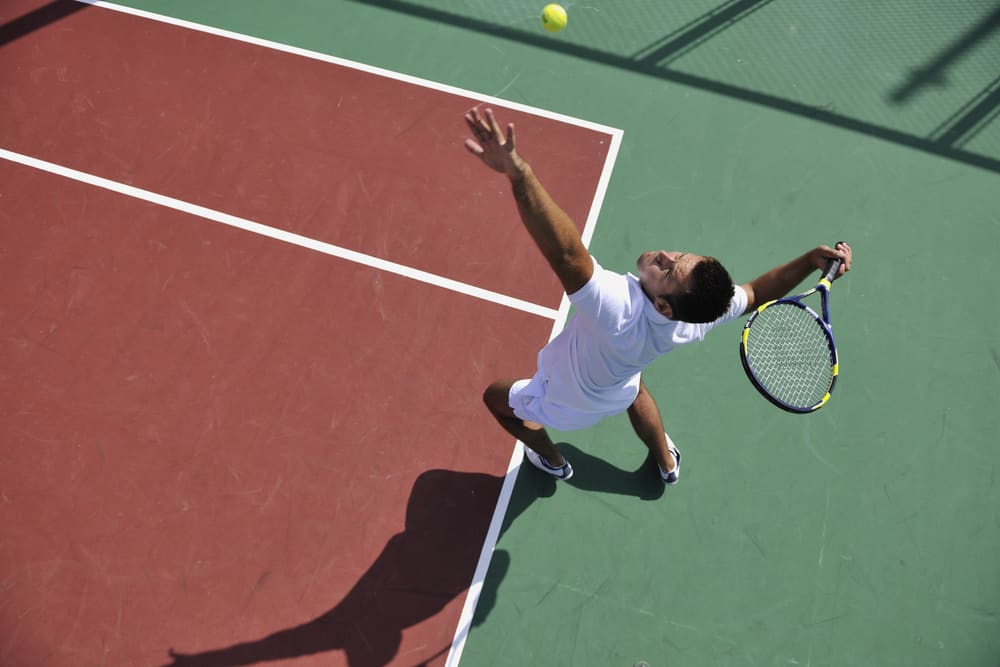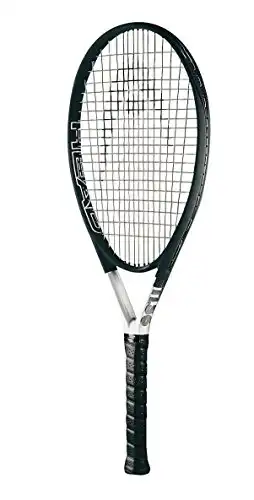What is a Let Ball in Tennis?
Have you ever watched a tennis match when the umpire stops play and calls out ‘let’? Things come to a halt, and you’re wondering what the reason could have been, not to mention what happens next. So, what is a Let Ball in tennis?
Key Takeaway:
A let ball in tennis is any hindrance to the players on the court that prevents a proper shot from being hit. If the umpire calls a let, play is stopped and the players replay the point from service. There are many types of lets, but the most common is when a serve hits the net and lands inbounds.
I’ll explain everything you need to know about let balls in the rest of this article. I’ll cover examples of let balls when you serve in tennis but a let can also occur after the serve. Like when a ball from the next court over rolls onto your court.
HEAD's Ti series has long been considered one of the best racquet series for beginners and the Ti S6 tops them all! It's a do-it-all type of racquet at a super affordable price!
Different Types of Lets in Tennis
An umpire might call many different types of let balls during a tennis match. One example is a service let when the ball clips the net but still lands in the proper service area. Some are so common that they might occur a dozen times, while others are rarer.
But no matter the type of let, the result is the same. Whether the ball hits the net or another disruption occurs, play is paused and reset. I’ll go over the different types of let balls in tennis below.
The Most Common “Let Balls” in Tennis
Net Balls
If a player hits the net during their first or second serve, it’s a let ball, but only if it lands in the service box. If the ball bounces off the net and lands out of bounds, the player loses that serve.
This is the most common type of let and can occur many times throughout a match.
To keep things simple, remember this simple fact. If on a serve the ball makes contact with the net but still lands in – it’s a “let”. If the ball hits the net and lands outside of the playing area – it’s a fault.
Fun Fact: Serving into the net on the second serve is also a fault.
Crowd Interruption
If you’ve ever watched professional tennis, you’ve probably seen players waiting for crowds to settle down. You may have even seen them complaining about interruptions. Like when the ball from another court rolls in, causing a let to be called.
These could be as simple as people yelling during a serve or as dangerous as shining laser pointers. This type of let also happens mostly during serves when the ball hits the net but still lands within the correct service box.
However, umpires may call them in the middle of a rally in extreme cases. The best tennis umpires will call a let if anyone in the crowd is distracting the players. This could happen at any point during the rally.
Objects Entering the Court
The last type of let involves objects entering the court. Whether it’s a professional match, an amateur tournament, or a game being played at the country club, this type of let is bound to occur from time to time.
Usually, this let is called because an extra ball has rolled onto the court. This happens a lot at local parks when someone from the adjacent court hits a ball onto another court. To prevent injury to players, play must be stopped.
Fun Fact: If there is a ball on the court from an adjacent court, play should stop even if someone hits a game-winner.

What Happens After a Let Is Called?
Now that you know what a let is, I’ll explain what happens in the aftermath.
After someone calls a service let, players replay the point from the beginning. This is when the ball touches the net but the service is otherwise correct.
During a service let, the server re-serves the ball from their first or second serve, depending on when the let happened. If it was a let during a rally, the serving player starts the point again from the first serve.
If the interruption comes from someone in the crowd, a warning may be issued and can escalate from there.
Awarding Points During a Let
No player receives a point when a service let is called. Typically this occurs when the ball hits the net during the serve but lands legally on the other side of the net.
Instead, both players replay the point from the beginning. This ensures that no player gains an unfair advantage or disadvantage from an interruption to play.
As a strictly governed sport with a long history, tennis has always strived for fair and courteous play.
Do Other Racket Sports Have the Let Rule?
Pickleball used to have the same let rule as tennis but did away with it in 2021. Now, there is no service lets in pickleball anymore. If the serve hits the net in pickleball and lands in, the point continues.
The same can be said for table tennis. When you serve in ping pong and the ball touches the net but still lands in, play continues.
Hitting the net during a serve in some other racquet sports can catch your opponents off balance. In some ways, this can give you a slight advantage as long as the ball is clearly in.
The Difference Between “Net” and “Let” In Tennis
If you’ve heard of ‘let balls’ in tennis, there’s a good chance that you’ve heard the term ‘net ball,’ too.
These two phrases usually refer to the same thing, as many people will refer to a ball that hits the net on a serve as a net ball. It’s also possible that the viewer hears the word ‘let’ but mistakes it for ‘net’ because of the context. This happens when a ball rolls to another court during play. In any case, the proper term to use is ‘let ball’ during serves.
Hitting the Net During a Rally
Net ball’ may also refer to any ball that hits the net during a tennis rally, but this has nothing to do with let balls. If a player’s shot hits the net and lands in bounds on the opponent’s side of the court, the players don’t replay the point.
Rallies won this way involve a lot of luck since players don’t normally try to hit the top of the net for an advantage. Because of this, most players accept the point and apologize to the opposing player for the bad bounce.
How Many Lets Are Allowed in Tennis?
You can probably imagine a scenario where two tennis players are endlessly trapped in a constant string of let serves, continuing to hit the net every time. Well, it’s not that far-fetched.
You’re allowed as many lets in tennis as necessary to ensure fair play. Players don’t get points after a let, and play begins from the start of a rally or serve. So, let balls can continue to happen for as long as necessary.
The chances of let balls continuing for eternity is small, but it could happen!

The Origin of the Word ‘Let’
The tennis term ‘let’ often refers to instances where the ball hits the net during a serve but the play continues. It comes from the Old Saxon or French word word ‘lettian,’ which translates roughly to ‘hindrance.’
As an old game with deep roots, tennis borrowed the base of this word to describe one of its rules. And, it makes perfect sense when you think about it.
Whenever a let ball happens in tennis, it’s technically a hindrance that doesn’t allow the players to play the game. ‘Let,’ or ‘hindrance,’ is called and players agree to restart the point.
The “No-Let” Rule in Tennis
Some college tennis tours, particularly in America, play ‘no-let rule’ tennis. As the name suggests, they don’t use the let rule. Because of this, serves that hit the net are considered legal. If they bounce off the net and land in bounds, the returning player must try to hit it.
This rule was introduced in collegiate tennis because players self-referee many games based on an honor system. Which, unfortunately, is a system that doesn’t always work.
As there was no way of ensuring that all players were calling serves fairly, a no-let rule was introduced. A no-let game of tennis might work for recreational purposes but not in sanctioned play.
Let Call – How to Properly Call a Let Serve
When it comes to tennis etiquette, there are some unwritten rules to consider if you’re going to call a let. First and foremost, the best thing you can do is call a let as early as possible. If someone hits the ball and a let ball has occurred, call it right away.
A let should be called loud and clear when a clear violation has occurred. If you’re unsure if one has occurred, then sportsmanship requires you to keep playing. Meaning, if it’s debatable, don’t call it.
Let Balls in Tennis – Final Thoughts
The let ball has been a part of tennis for a long time. It’s there to guarantee that players have a level playing field and are winning games with their skill alone.
Though no-let tennis is played in some corners of the tennis world, it’s uncommon, and leagues only institute it out of necessity. Now go put the ball in play and “let” the fun begin!
Other Let Ball FAQs
Q: When can a let be called in a tennis match?
A: A let can be called if there is interference during a point, such as a ball rolling onto the court or a player calling out during play.
Q: Who has the authority to call a let during a tennis game?
A: The umpire or the players themselves may call a let in a tennis match if they believe there has been interference that warrants a replay. Remember, in tournament play, an umpire may call a let at any point.
Q: What are the tennis let rules regarding a serve?
A: If a tennis serve hits the net cord but still lands in the correct service court, it is considered a let and the serve is replayed. You get an unlimited number of service lets in a row, as long as your serve lands in after striking the net.
Q: Can a let be called if a ball from a nearby court enters the playing area?
A: Yes, if a ball from a nearby court rolls onto the court during a point, it is considered interference and a let can be called.
Q: How many lets in a row are allowed in a tennis match?
A: There is no limit to the number of lets that can be called in a row during a tennis match. Each interference incident warrants a replay of the point. Service lets are unlimited if they continue to land in. If a serve lands out, it is a fault, and the serve is lost.
Q: What does it mean when a player says “let” in tennis?
A: When a player says “let” during play, they are indicating that they believe there has been interference that requires a point to be replayed.
Q: Are there specific rules regarding when a player can call a let in tennis?
A: Yes, players have the right to call a let as soon as they believe interference has occurred that warrants a replay of the point, in accordance with the rules of tennis.
Q: Is A Let Considered a Fault?
A: No. Unlike fault, a let call never results in a point. Faults result in points being earned while lets represent a stoppage of play. A let and a fault are two different aspects of tennis.

Welcome to TheVolleyLlama.com. My name is Keith, I’m just a lover of all sports that involve a racquet, net and a ball. I played competitive high school varsity tennis, love racquetball and my whole family plays pickleball regularly. I started this website to help give people like you the basics to learn these wonderful games.



